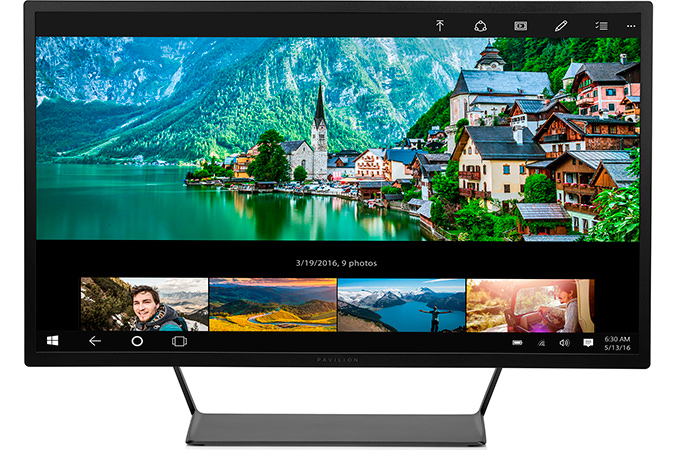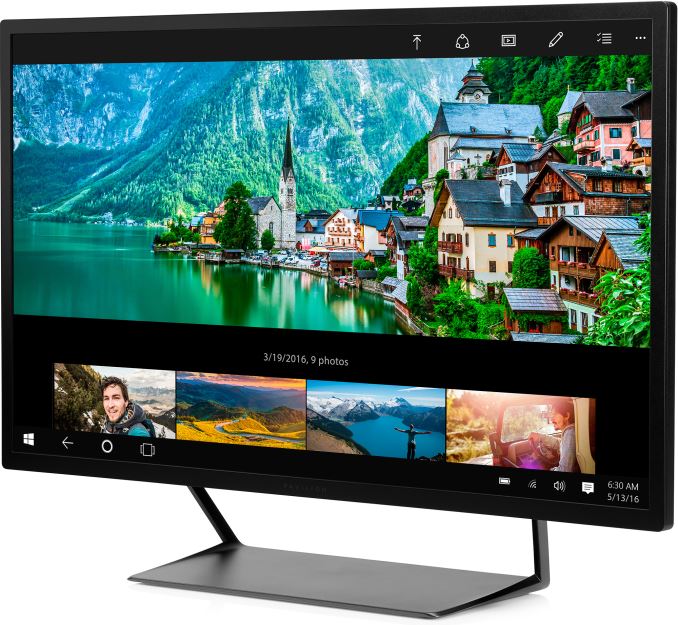HP Announces 32” Pavilion Display for Everyone: QHD for $399
by Anton Shilov on May 4, 2016 11:05 AM EST
HP has introduced its Pavilion 32 display (V1M69A), which promises to combine large size, QHD resolution, VA panel and affordability. The Pavilion 32 monitor may not appeal to professionals or hardcore gamers, but for mainstream users this one could be a game changer because of its price-point. The monitor will hit the market late next month as a part of HP’s back-to-school product refresh.
Modern day desktop workloads involve a lot of multitasking as well as long documents, large spreadsheets and high-resolution images. For many tasks, big displays are not a luxury, but rather a necessity. However, it is not easy to find a monitor that boasts with a large size, a good quality panel and an affordable price. There are relatively inexpensive 24” and 27” monitors with IPS or VA panels available, but when it comes to models with diagonals like 30” and larger, then it is not easy to find a good quality affordable display. While there are low-priced 32” monitors from unknown brands, they usually feature cheap TN panels and can hardly boast with good quality. Meanwhile, well-known suppliers charge $500 and up for their 32” models, which is more than many people are willing to spend on a display. With its Pavilion 32, HP wants to address the market of affordable monitors with an offering that is currently not available from its rivals.
The HP Pavilion 32 (V1M69A) display uses a 32" WVA+ panel with 2560×1440 resolution, 300 cd/m2 brightness, 3000:1 static contrast ratio, 178°/178° horizontal/vertical viewing angles as well as 60 Hz refresh rate. WVA stands for wide viewing angle, which is a general term to describe various types of panels (including *VA and PLS) used by display makers in their products. HP does not disclose exact type of the panel that powers the Pavilion 32”, but confirms that this is a VA panel (though, we have no idea whether this is AH-VA, A-MVA, etc.), not a TN (which is typically used for low-cost displays). In many ways, the Pavilion 32 resembles the Envy 32 monitor, which HP introduced several months ago. The Envy 32 has a similar WVA+ panel, but features stereo speakers as well as AMD’s FreeSync to appeal to gamers, but it is also more expensive.
| Specifications of HP Pavilion 32 and HP Envy 32 | ||||
| HP Pavilion 32 V1M69A |
HP Envy 32 N9C43AA |
|||
| Panel | 32" WVA+ | 32" WVA+ with Anti-Glare | ||
| Resolution | 2560 × 1440 | |||
| Refresh Rate | 60 Hz | 60 Hz with AMD FreeSync | ||
| Response Time | 7 ms gray-to-gray | |||
| Brightness | 300 cd/m² | |||
| Contrast | 3000:1 | |||
| Viewing Angles | 178°/178° horizontal/vertical | |||
| Color Saturation | 100% sRGB | |||
| Pixel Pitch | 0.276 mm | |||
| Pixel Density | 91.8 pixels per inch | |||
| Inputs | 2 × HDMI 1 × DP 1.2 |
1 × HDMI 1 × MHL 1 × DP 1.2 3.5 mm stereo-in |
||
| USB Hub | 2-port USB 2.0 hub | |||
| Audio | None | Stereo speakers with Bang & Olufsen enhancements |
||
| Launch Price | $399.99 | $499.99 | ||
The new Pavilion 32 display from HP is equipped with two HDMI and one DisplayPort 1.2 connectors (cables are included in the package). In addition, it has an integrated USB 2.0 hub, which should be enough to connect a keyboard, but which will not be sufficient for modern external USB flash memory drives that support USB 3.0 transfer rates. Keeping in mind that the hub is located on the backside of the monitor, it looks like it was not intended for removable storage in general. The design of the Pavilion 32 allows adjusting tilt, but not height. Asides from that, the monitor cannot be used in portrait mode, which is hardly a problem for the vast majority of its potential buyers.
Select retailers as well as HP’s online store will start to sell the HP Pavilion 32 on June 26 for $399.99. The monitor is covered by a one- or three year-limited warranty.
The key selling points of the HP Pavilion 32 are its relatively low price as well as its VA panel. Right now, the majority of 32” displays with QHD resolution from well-known suppliers cost over $500. By making its product available for $400, HP appeals to a broader audience of users, who currently buy smaller monitors. What remains to be seen is whether other display makers follow HP with their inexpensive 30” QHD parts.
Source: HP











74 Comments
View All Comments
JoeyJoJo123 - Thursday, May 5, 2016 - link
>These whole "p" nomenclature refers to the vertical resolution of 16:9 displaysThat's where you're wrong, millennial.
Back before you were born, there were these things called "CRT Televisions", or Cathode Ray Tube Televisions. For consumers, these typically supported 240p and 480i resolutions, or 320x240 resolution at ~60hz, progressive scan, or 640x480 resolution at ~60hz, interlaced scan, respectively.
The "p" signifies that it's progressive scan, meaning each refresh cycle the entire frame is redrawn (as opposed to half the screen, with alternating horizontal lines, during interlaced scan) and nothing more. The number before the "p" discloses the verticle frame resolution. 1600p = 2560x1600 progressive scan.
mdriftmeyer - Friday, May 6, 2016 - link
Also spot on.euskalzabe - Thursday, May 12, 2016 - link
Well said. Also, I'm kind of amazed that we're even having this P/I and resolution conversation. Why don't people google stuff and learn from the vast internet instead of ignorantly saying things in forums?That said, I kinda miss my 17" Syncmaster. Only 768p (that's 1024x768 for the young kids, not 1280x768) but even at just 75hz it looked glorious.
erple2 - Friday, May 6, 2016 - link
"p" used to refer to progressive, which was a time when there was also "i", or interlaced. Since we mostly all use LCD panels these days (other than a few extremely expensive (high end) or extremely cheap (ultra low end)), the "p" doesn't really mean anything anymore.StormyParis - Wednesday, May 4, 2016 - link
Indeed. I'm moved to several screens instead of a larger one. Depends on your work I guess, but for me, it's both cheaper and more productive.nathanddrews - Wednesday, May 4, 2016 - link
No way. For old people and people with bad eyesight, this is a great display. My dad uses a 32" 1080p VA TV as a monitor, 1) because it was $150 on sale, and 2) he can actually see the screen. In truth, it looks decent at normal distance. Pixelated, but nice.IMO, bigger is usually better, even if pixel density isn't at the ordained, appropriate arc-minute proximity. The human brain can endure quite a bit when it is being wowed by content filling the scope of vision.
That said, I would spring for the FreeSync version if I were in the market.
Murloc - Wednesday, May 4, 2016 - link
old people, okay, but I aim at not being able to see the pixels.Arnulf - Thursday, May 5, 2016 - link
Don't worry, nature will take care of that for you sooner or later.Agent Smith - Thursday, May 5, 2016 - link
Determine Viewing DistanceFirst get a high quality picture from the web, PNG ideally and preferrably one with high contrasts and sharp edges, now open up GIMP (or any other image manipulation program) and reduce the resolution by half for each axis (i.e. turn a 1920*1080 picture into a 960*540 picture) save that picture as a seperate copy.
Now open both copies and place each on one half of the screen, enhance the zoom factor on the smaller picture to 200% so that both are exactly the same size, also try align the exact same section of the picture on both.
Now step back a considerable distance, so you can't make out any difference between the 2 pictures whatsoever, and slowly walk towards the monitor, stop as soon as you notice a difference between the pictures (can also make a "blind test" by having a friend realign the pictures when you're not looking.. no fooling yourself that way) now measure the distance from your eyes to the screen.
Divide that distance by two (since you enlarged the pixelated picture by two thus dividing its DPI by 2) and you've got your optimal viewing distance for that screen resolution and screen size.
If you did that for a 1080p screen and want to know the result for a hypothetical UHD screen of the same size just divide the distance by 2 another time (since vertical and horizontal resolution increases twofold with UHD)
You can also extrapolate linearly to larger screen sizes.
So if you had a distance of say 5m for a 30" screen with FHD, divide that by 2-> 2.5m, now extrapolate it to e.g. 55" -> 2.5 * 55/30 = 4.6m now divide by 2 for UHD -> 2.3
Samus - Friday, May 6, 2016 - link
I've always liked this method but on larger "4K" displays, it has me sitting too close and causes my head to move too much. The purpose of the "divide dpi" method is to set you back just far enough so your eyes do the moving, not your neck muscles.Basically my rule of thumb is follow the method and add the length of your chair seat to the distance as a buffer.